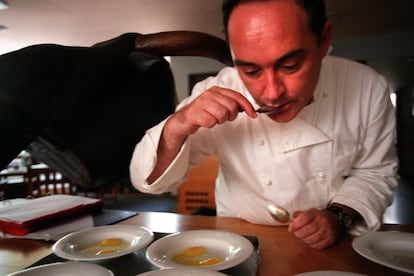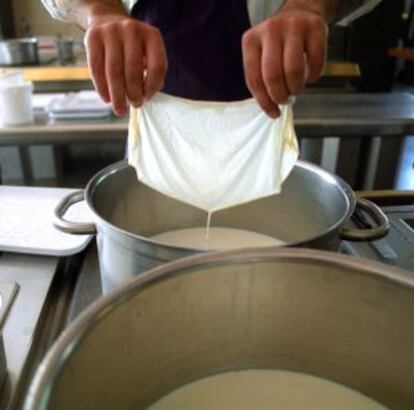Food for thought: eating with your intellect
Catalan avant-garde chef Ferran Adri¨¤, of 'El Bulli', publishes his theory of cooking

He is the man of the moment. Although the name Ferran Adri¨¤ has been pronounced in reverential tones for years by those in the know, it seems like everyone is now talking about the Catalan chef who is making ¡°nouvelle cuisine¡± sound, well, old.
His creations tread the line between food and art, so much so that a Madrid art gallery, Galer¨ªa Atalante, just opened a show with photographs of his most visually arresting dishes.
His definitive international consecration came last August, when The New York Times critic Arthur Lubow wrote an ecstatic article about Adri¨¤, calling his restaurant El Bulli, outside Barcelona, ¡°a gastronome¡¯s once-before-you-die mecca.¡±
The ultimate aim is to introduce reason into the eating experience¡±
In a statement that made waves in the food world, Lubow asserted that France is no longer the engine of culinary innovation, giving that title instead to Spain.
¡°The effervescence that buoyed French nouvelle cuisine in the 1970s has somehow been piped across the Pyrenees,¡± Lubow wrote. And Adri¨¤ is leading this new wave of Spanish experimental cooking, which he himself likes to call avant-garde cuisine.
In 1983 he began working in the kitchens of El Bulli, a restaurant in the Catalan town of Roses, in the province of Girona. Three years later Adri¨¤ was promoted to head chef, and by 1990 the manager, Juli Soler, had offered him co-ownership.
Making creativity his leitmotiv, Adri¨¤ turned the restaurant into a great experimental food laboratory, turning out dishes that made people sit up and take notice, and steadily anchoring his reputation as the epitome of gastronomic sophistication.
These days, El Bulli is open only six months out of the year, and there are months-long waiting lists for a chance to dine at this most exclusive of establishments.
After some intense experimentation at the El Bulli workshop, opened in 2000 to complement the restaurant, Adri¨¤ decided in 2002 to step back and review his own evolution to determine what direction El Bulli should take in the future.
So instead of producing brave new dishes, he spent the year producing a book that would bring together not just his recipes, but also his philosophy.

elBulli 1983-2002 is a work of gargantuan proportions, so immense that it had to be divided into three separate volumes, divided by chronological periods and the last of which, elBulli 1998-2002, is now being distributed in English by Gourmand, an organization that hands out the world¡¯s most important cookbook awards each year.
elBulli 1983-2002 cannot be described as a conventional cookbook, though it includes a myriad of recipes, truly spectacular photography and behind-the-scenes videos on a companion CD-ROM. Structured like an art catalogue, it is ¡°conceived as a tool for understanding and explaining our work from a theoretical standpoint,¡± in the words of the author.
This theory includes the use of terms like association, deconstruction and decontextualization to talk about food, and a map of El Bulli¡¯s creative evolution since 1983. There is even a 53-image code that was developed to classify each ingredient, as well as a description of the technological innovations that the core team - Ferran, his brother Albert and their chef de cuisine Oriol Castro - have come up with to accommodate outlandish dishes like liquid croquettes, bread airbags, solid beer and popcorn powder.
Will it be possible to see dishes whose models are futurism, abstraction, pop art?¡±
In some cases, they went as far as hiring industrial designers to create new eating utensils altogether, like the pipette or the slurp. The basic menu structure - starters, main course, desserts - also suffered modifications at the hands of these Dr Moreaus of the kitchen, who came up with new categories like pre-desserts, morphs and follies.
A good indication of just how far this innovative spirit is taken is the following quote from the book: ¡°The knowledge of physics may be one of the most fertile routes to creativity in the kitchen.¡± Indeed, some of their creations seem to defy gravity itself, like the parmesan-on-a-stick.
But this is what it¡¯s all about - making the dish a new experience for all the senses, not just the sense of taste. Adri¨¤ in fact talks about the ¡°sixth sense¡± when thinking up new plates. This entails provoking a certain feeling in the diner¡¯s mind, such as irony, or even bringing back a childhood memory. The ultimate aim is to introduce reason into the eating experience, or ¡°the ability to enjoy cooking not only with one¡¯s palate, but also with one¡¯s intelligence.¡±
The experience comes at a price. The men¨² de degustaci¨®n in April 2001 would have set you back nearly 17,000 pesetas (over €100). But then you would have enjoyed 25 separate and most unusual dishes like Chicken Feet Crackling, Mock Popcorn, Rose Petals in Tempura, Textured Pumpkin with Deconstituted Grapefuit and Chocolate in Declension.
In the end, perhaps it¡¯s all about accommodating the relentless demand for novelty in a world full of jaded consumers who have simply seen it all.
Adri¨¤ talks about this issue when he refers to the ¡°limits of creativity in our cuisine¡± and the growing pressure to satisfy a type of public looking for the latest ¡°new new thing.¡±
¡°Trying to come up with an answer to this question is one of the reasons why we have decided to take a sabbatical year off, creatively speaking,¡± he says in the closing pages of the book. ¡°What direction should our cuisine take? Can it adopt as an example other fields and eras and transfer to its own area? In future, will it be possible to see dishes whose models are futurism, abstraction, pop art or any other movement? This question has given rise to a great many hours of thought, and we have a good many ideas about it. But we always end up thinking that the most important and essential aspect of cooking is taste.¡±
¡°It is essential to ensure that these ideas do not end up turning a creative and experimental restaurant into a performance. Even so, the door must be kept open to all new ideas, otherwise we would be betraying our principles. The next two or three years will be important signposts to show which directions to take.¡±
Tu suscripci¨®n se est¨¢ usando en otro dispositivo
?Quieres a?adir otro usuario a tu suscripci¨®n?
Si contin¨²as leyendo en este dispositivo, no se podr¨¢ leer en el otro.
FlechaTu suscripci¨®n se est¨¢ usando en otro dispositivo y solo puedes acceder a EL PA?S desde un dispositivo a la vez.
Si quieres compartir tu cuenta, cambia tu suscripci¨®n a la modalidad Premium, as¨ª podr¨¢s a?adir otro usuario. Cada uno acceder¨¢ con su propia cuenta de email, lo que os permitir¨¢ personalizar vuestra experiencia en EL PA?S.
En el caso de no saber qui¨¦n est¨¢ usando tu cuenta, te recomendamos cambiar tu contrase?a aqu¨ª.
Si decides continuar compartiendo tu cuenta, este mensaje se mostrar¨¢ en tu dispositivo y en el de la otra persona que est¨¢ usando tu cuenta de forma indefinida, afectando a tu experiencia de lectura. Puedes consultar aqu¨ª los t¨¦rminos y condiciones de la suscripci¨®n digital.








































